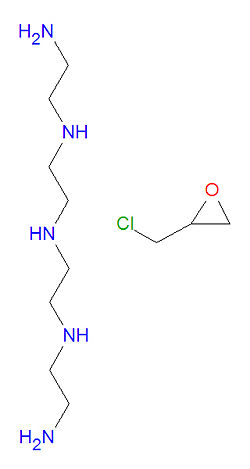Colestipol: Difference between revisions
imported>David E. Volk mNo edit summary |
imported>Milton Beychok (Undo revision 100471700 by David E. Volk (Talk) Undid inadvertant deletion by David Volk) |
||
| Line 5: | Line 5: | ||
Colestipol hydrochloride binds [[bile acid]]s in the intestine forming a complex that is excreted in the feces, which blocks the reabsorption of the bile acids and their associated fats. The diminished levels of bile acids leads to upregulation of the enzyme [[cholesterol 7-(alpha)-hydroxylase]], which increases the conversion of cholesterol to bile acids. The increased demand for cholesterol has the dual effect of increasing transcription and activity of the cholesterol biosynthetic enzyme [[HMG-CoA reductase]], and increasing the number of hepatic low-density lipoprotein (LDL) receptors. These compensatory effects result in increased clearance of LDL cholesterol (LDL-C) from the blood leading to decreased serum LDL levels. | Colestipol hydrochloride binds [[bile acid]]s in the intestine forming a complex that is excreted in the feces, which blocks the reabsorption of the bile acids and their associated fats. The diminished levels of bile acids leads to upregulation of the enzyme [[cholesterol 7-(alpha)-hydroxylase]], which increases the conversion of cholesterol to bile acids. The increased demand for cholesterol has the dual effect of increasing transcription and activity of the cholesterol biosynthetic enzyme [[HMG-CoA reductase]], and increasing the number of hepatic low-density lipoprotein (LDL) receptors. These compensatory effects result in increased clearance of LDL cholesterol (LDL-C) from the blood leading to decreased serum LDL levels. | ||
== Drug Interactions == | |||
Colestipol, a gastrointestinal binding agent, decreases the absorption and thus effectiveness of several drugs. It decreases the anticoagulant effects of [[anisindione]], [[dicumarol]], [[acenocoumarol]] and [[warfarin]]. It also decreases the absorption of the [[thyroid hormone]]s [[levothyroxine]], [[liothyronine]], [[liotrix]] and [[thyroglobulin]]. Other drugs whose effects are lessened include [[digoxin]], [[fluvastatin]], [[hydrocortisone]], [[raloxifene]] and [[ursodeoxycholic acid]]. | |||
== External Links == | |||
* {{DailyMed}} | |||
* {{MedMaster}} | |||
* {{DrugBank}} | |||
Revision as of 12:16, 6 April 2009
Colestipol, sold under the brand names Cholestabyl and Colestid, is a highly crosslinked insoluble basic anion exchange resin used to reduce cholesterol. It may also may reduce triglyceride levels.
Colestipol hydrochloride binds bile acids in the intestine forming a complex that is excreted in the feces, which blocks the reabsorption of the bile acids and their associated fats. The diminished levels of bile acids leads to upregulation of the enzyme cholesterol 7-(alpha)-hydroxylase, which increases the conversion of cholesterol to bile acids. The increased demand for cholesterol has the dual effect of increasing transcription and activity of the cholesterol biosynthetic enzyme HMG-CoA reductase, and increasing the number of hepatic low-density lipoprotein (LDL) receptors. These compensatory effects result in increased clearance of LDL cholesterol (LDL-C) from the blood leading to decreased serum LDL levels.
Drug Interactions
Colestipol, a gastrointestinal binding agent, decreases the absorption and thus effectiveness of several drugs. It decreases the anticoagulant effects of anisindione, dicumarol, acenocoumarol and warfarin. It also decreases the absorption of the thyroid hormones levothyroxine, liothyronine, liotrix and thyroglobulin. Other drugs whose effects are lessened include digoxin, fluvastatin, hydrocortisone, raloxifene and ursodeoxycholic acid.
External Links
- Colestipol - FDA approved drug information (drug label) from DailyMed (U.S. National Library of Medicine).
- Template:MedMaster
- Template:DrugBank
